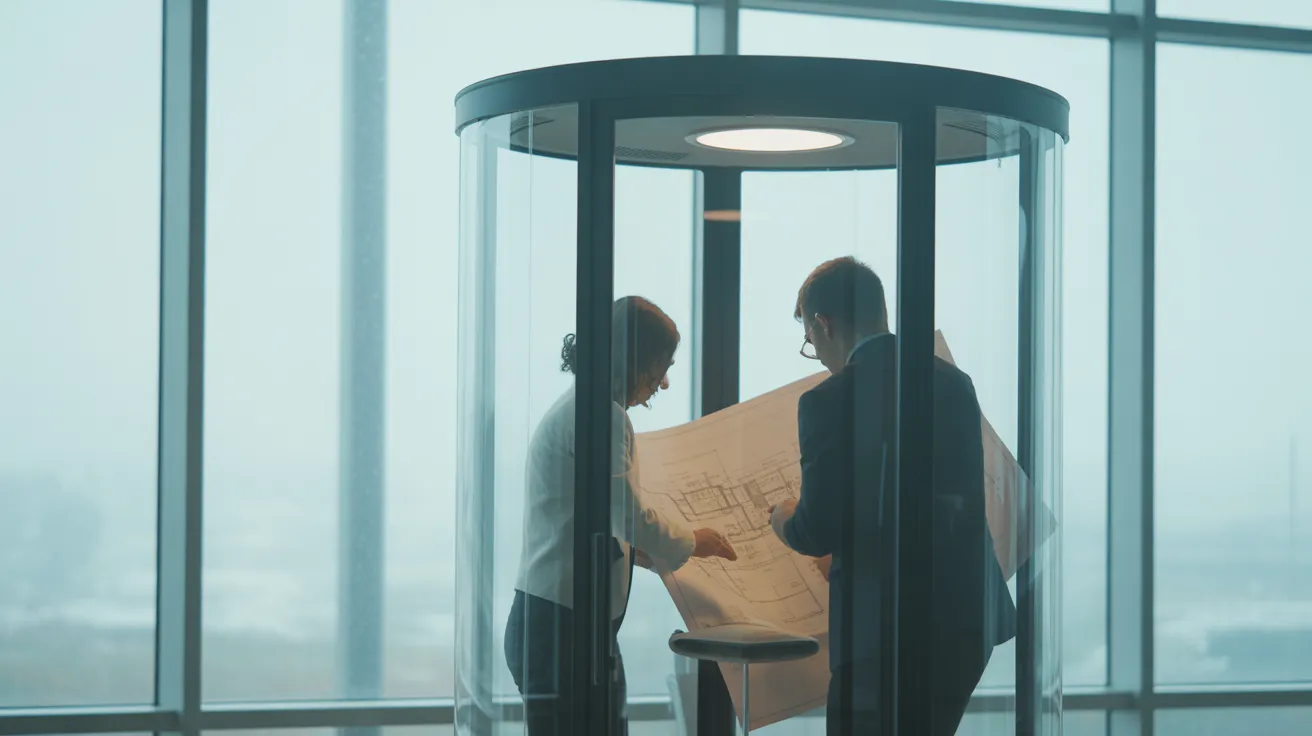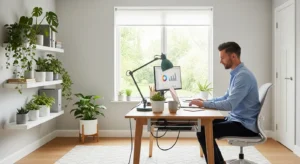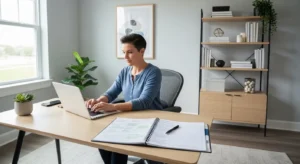
The life of a digital nomad is a study in beautiful contradictions. You are free, yet tethered to Wi-Fi. You are an explorer, yet your most constant companion is often a glowing screen. This lifestyle, built on the promise of liberation through technology, can quietly become a cage of digital distraction, burnout, and a constant, low-grade sense of disconnection.
You feel it, don’t you? The phantom buzz in your pocket. The reflexive reach for your phone the moment a thought goes unfinished. The subtle anxiety of an unread notification badge. This isn’t a personal failing; it’s a feature of the modern digital landscape. The very tools that enable our freedom are engineered to capture and hold our most valuable resource: our attention.
The cost of this constant distraction is steep. It fragments our focus, erodes our ability for deep work, and can leave us feeling isolated even in the most beautiful, bustling new city. Productivity wanes, creativity suffers, and the vibrant world we set out to explore becomes a mere backdrop to our digital interactions.
But here is the good news: you do not have to choose between your digital career and your mental peace. This is not a guide about quitting technology or abandoning the lifestyle you love. Instead, this is a survival guide. It’s about understanding the forces at play, reclaiming your focus, and creating intentional, healthy boundaries with your devices. It’s about learning to stay grounded in a tech-saturated world, so you can truly thrive wherever you go.
📚 Table of Contents
- Understanding the Attention Economy: Why It’s So Hard to Look Away
- Creating Your Digital Sanctuary: Practical Routines
- Master Your Focus Modes
- Triage and Batch Your Notifications
- Curate Your Home Screen
- Use App Timers Consciously
- Designing Your Physical Environment for Digital Peace
- Putting It Into Practice: Two Grounding Exercises
- Navigating the Inevitable: Troubleshooting Your Journey
- Handling “Relapse” Moments
- Managing FOMO (Fear of Missing Out)
- Dealing with Social and Professional Expectations
- Frequently Asked Questions
- Are digital wellness apps that track my screen time a good idea? What about privacy?
- I work with a team in a different time zone and often have to work late at night. How can I manage blue light and have a wind-down routine?
- I’m a digital nomad parent. How can I model good habits for my kids while still needing to be connected for work?
- My boss or clients expect me to be available 24/7. How can I set boundaries without seeming unproductive or uncommitted?
- Your First Steps to a More Grounded Life
Understanding the Attention Economy: Why It’s So Hard to Look Away
Before we can build healthier habits, we must first understand why our current ones are so deeply ingrained. The feeling of being “addicted” to your phone isn’t just a feeling; it’s the result of a carefully designed system. We live and work within what is known as the “attention economy,” where your focus is the commodity being bought and sold.
At the heart of this system is a powerful psychological principle. Many apps and platforms are built to trigger a dopamine loop. Dopamine is a neurotransmitter in your brain associated with pleasure, motivation, and reward. When you do something that feels good, like eating a delicious meal or receiving a compliment, your brain releases a small hit of dopamine, reinforcing that behavior.
Technology companies have become masters at creating these loops. Think about the “pull-to-refresh” feature on your social media feed. You pull down, and you might see a new, interesting post, or you might see nothing. This unpredictability, known as a variable reward schedule, is incredibly compelling. Each pull is a small gamble, and the potential for a “win”—a new like, a funny video, an important email—releases a tiny burst of dopamine. This keeps you coming back for more, again and again.
Notifications work in the same way. The red badge, the buzz, the banner—they all signal a potential reward. It could be a message from a loved one, a work update, or just a trivial app alert. The uncertainty is what makes it so hard to ignore. We are biologically wired to pay attention to new and novel stimuli, a survival trait that is now being leveraged to keep us constantly engaged with our devices.
For a digital nomad, this is amplified. Your phone isn’t just for fun; it’s your office, your map, your translator, and your primary link to friends and family back home. The lines between work and life, essential and trivial, are perpetually blurred. An incoming notification could be your next client or a 20% off coupon. This constant state of alert readiness is mentally exhausting and is the first thing we must learn to manage.
Recognizing these patterns is not about placing blame. It is about empowerment. When you understand the mechanics of how your attention is being captured, you can begin to consciously dismantle the system and build one that serves your well-being instead of a company’s engagement metrics. You can move from being a passive consumer of technology to an intentional architect of your digital life. For more on the science of behavior, resources from organizations like the American Psychological Association (APA) provide extensive research.

Creating Your Digital Sanctuary: Practical Routines
The first step to reclaiming your attention is to take control of your primary device: your smartphone. Instead of a chaotic portal of endless distraction, you can transform it into a tool for focused work and intentional connection. This requires setting up systems and routines that put you, not the apps, in the driver’s seat.
Master Your Focus Modes
Most modern smartphones have powerful “Focus” or “Do Not Disturb” (DND) settings that go far beyond a simple silent switch. DND is a state where your device will not audibly or physically alert you to incoming calls, texts, or notifications. Modern versions of this allow you to customize who and what can get through.
Instead of just one DND mode, create several for different contexts of your nomadic life. For example:
Deep Work Mode: This mode should be your fortress of solitude. It silences all notifications except for calls from a few emergency contacts (like a partner or family member). It can also change your home screen to show only work-related apps like your project manager, email client, and a notepad. You can set this to activate automatically when you’re at a coworking space or during specific hours.
Personal Time Mode: When the workday is done, this mode can hide your work apps and notifications. It might allow messages from all your contacts but keep app alerts silenced. This creates a clear boundary, signaling to your brain that it’s time to switch off from professional responsibilities.
Explore Mode: When you’re out discovering a new city, the last thing you want is a work email pulling you out of the moment. This mode could limit notifications to mapping apps, translation tools, and messaging apps, keeping the digital noise to a minimum so you can be present in your physical surroundings.
Triage and Batch Your Notifications
A constant stream of notifications is the enemy of deep thought. The solution is notification batching. This is the practice of checking your notifications at specific, scheduled times rather than reacting to them as they arrive. It’s like checking your physical mailbox once a day instead of running outside every time a car drives by.
Start by performing a notification audit. Go into your phone’s settings and turn off notifications for every single app that is not absolutely essential for time-sensitive communication. Be ruthless. Does your food delivery app really need to send you push alerts? Does that game need to tell you your energy is refilled?
For the apps that remain, group them by priority. You might decide to check work emails at 9 AM, 1 PM, and 4 PM. Social media notifications can wait until your lunch break or the evening. By setting these simple rules, you break the reactive cycle and regain control over your time and attention.
Curate Your Home Screen
Your home screen is the front door to your digital world. If it’s cluttered with distracting, dopamine-triggering apps, you’re setting yourself up for failure every time you unlock your phone. Design it with intention.
Move all social media, news, and entertainment apps off the first page. Place them in a folder on the second or third page, forcing you to make a conscious effort to open them. Your primary home screen should contain only utility-based tools: your calendar, a notes app, maps, your camera, and perhaps a meditation or weather app. By removing the visual triggers, you reduce the temptation for mindless scrolling.
Use App Timers Consciously
Many of us open an app for a specific reason, only to get lost for 30 minutes in an endless feed. App timers can be your safeguard. Set daily time limits for your most-used distracting apps. When your time is up, the app will be blocked for the rest of the day.
This isn’t about punishment; it’s about awareness. The first few times you hit your limit, it might feel jarring. But it serves as a powerful reminder of how quickly time can slip away. It forces you to be more intentional with your screen time, asking yourself, “Is this the best use of my limited time on this platform right now?” Over time, you’ll find yourself using these apps more purposefully and for shorter durations.

Designing Your Physical Environment for Digital Peace
Digital wellness isn’t just about what you do on your phone; it’s also about how you structure your physical world. As a digital nomad, your environment is constantly changing, which presents both a challenge and an opportunity. You can consciously design each new space—be it an Airbnb, a hotel room, or a cafe—to support your goal of staying grounded.
Establish Screen-Free Zones
The most powerful environmental change you can make is to designate certain areas as completely screen-free. This creates a physical boundary that reinforces your mental boundaries.
The most important screen-free zone is your bedroom. Your bed should be for sleep and intimacy only. Bringing a phone, tablet, or laptop into bed trains your brain to associate that space with the stimulating glow of a screen, work stress, and endless information. This can severely disrupt your ability to wind down and fall asleep. Buy a cheap, old-fashioned alarm clock and charge your phone overnight in another room, like the kitchen or living area. This single habit can dramatically improve your sleep quality and your morning focus.
Another powerful zone is the dinner table. Whether you’re eating alone or with others, make it a rule to put all devices away. This allows you to mindfully enjoy your food and be fully present in the moment or in conversation. It’s a small act of reclaiming a fundamental human experience from digital intrusion.
Cultivate Sleep-Friendly Evenings
A good day of focused work begins the night before with quality sleep. One of the biggest obstacles to rest in our modern world is our exposure to screens in the evening. The screens on our devices emit high concentrations of blue light. This is a type of light on the visible spectrum that our brains interpret as daylight. Exposure to it in the hours before bed can suppress the production of melatonin, the hormone that regulates your sleep-wake cycle.
According to experts at organizations like the Sleep Foundation, this can make it harder to fall asleep and can reduce the quality of your rest. To counter this, establish a digital sunset. Set an alarm for 60-90 minutes before your intended bedtime. When it goes off, all screens go off. Use this time for analog activities: read a physical book, stretch, journal, listen to calming music, or talk with a partner. This wind-down period is crucial for signaling to your mind and body that it’s time to prepare for sleep.
Create Cues for Deep Work
Just as you have routines to wind down, you need routines to ramp up for focused work. Because your “office” changes frequently, creating consistent environmental cues can help you get into a state of flow more quickly, regardless of your location.
These cues can be simple. Maybe it’s a specific type of music you only listen to when working, like classical or ambient electronic. Perhaps it’s lighting a specific scented candle or making a certain kind of tea. Putting on noise-canceling headphones, even with no music playing, can be a powerful signal to both yourself and others that you are entering a period of deep concentration.
The key is consistency. By repeatedly associating these sensory cues with focused effort, you create a conditioned response. Over time, simply performing this small ritual will help your brain transition into work mode more efficiently, helping you maximize your productivity and protect your precious free time for exploration and rest.

Putting It Into Practice: Two Grounding Exercises
Theory is valuable, but practice is what creates change. Let’s move from the abstract to the concrete with two simple, actionable exercises you can implement immediately to start building a healthier relationship with your technology. These aren’t about drastic overhauls; they are about small, sustainable shifts.
A 10-Minute Evening Wind-Down
The goal of this exercise is to replace 10 minutes of evening screen time with a mindful, analog activity. The transition from a hyper-stimulated state to a restful one is often the hardest part of the day. This routine helps bridge that gap.
Step 1: Set a “Digital Sunset” Alarm. Choose a time, ideally 60 minutes before you want to be asleep, and set a daily alarm on your phone with the label “Begin Wind-Down.”
Step 2: Physically Move Your Phone. When the alarm goes off, your only task is to plug your phone in to charge for the night in a room that is *not* your bedroom. Place it in the kitchen, the living room, or even a drawer. The physical act of putting it away is crucial.
Step 3: Choose Your Analog Activity. For the next 10 minutes, engage in something that doesn’t involve a screen. You could do some light stretching, tidy up your space for the morning, write down three things you were grateful for that day in a physical journal, or simply sit quietly and focus on your breath. The activity itself matters less than the act of disconnection.
Step 4: Prepare for Tomorrow. Use the last few minutes to do one small thing that will make your morning easier. Lay out your clothes, prepare your coffee maker, or pack your bag for the coworking space. This creates a sense of calm and control, ending your day on a proactive note.
This simple 10-minute routine breaks the cycle of late-night scrolling, reduces blue light exposure, and gives your mind the space it needs to prepare for restorative sleep. It’s a small investment with a huge return on your well-being.
The Realistic Weekend Digital Detox
The idea of a full weekend without technology is daunting and often impractical for a digital nomad. This “detox” is different. It’s not about elimination; it’s about intentional reduction and re-focusing your energy on the world around you. The goal is to spend one weekend day being a creator and experiencer, not just a consumer.
Here is a sample plan. Feel free to adapt it to your own needs and location.
- Morning (Until Noon): Analog First. The rule is simple: no social media, no news, no non-essential emails before 12 PM. Use your phone only for essentials like maps, calling a friend, or looking up cafe hours. Spend the morning doing something physical and local. Go for a long walk in a new neighborhood, visit a farmer’s market, or try a local fitness class. Experience your location with your senses, not through a screen.
- Afternoon (Noon to 5 PM): The Single-Tasking Window. If you need to use technology, practice single-tasking. Want to catch up with family? Schedule a video call, and during that call, do nothing else. No scrolling, no multitasking. Want to edit photos from your week? Transfer them to your laptop and focus only on that creative task. The goal is to use technology for a specific, fulfilling purpose rather than for passive consumption.
- Evening (After 5 PM): Entertainment, Reimagined. Instead of defaulting to streaming a movie on your laptop, seek out an analog or communal form of entertainment. Find a local live music venue, go to a public screening in a park, or simply read a physical book in a quiet cafe. If you do watch something, make it a deliberate choice—a specific film you’ve been wanting to see—rather than aimless channel surfing.
This approach helps you reset your digital habits without creating anxiety about being completely disconnected. It reminds you that your devices are tools to be used, not anchors that dictate how you spend your free time.

Navigating the Inevitable: Troubleshooting Your Journey
Building new habits is a non-linear process. There will be days when you fall back into old patterns. You’ll mindlessly scroll, miss your digital sunset, or get distracted during deep work. This is not a failure; it is a normal and expected part of the journey. The key is to approach these moments with self-compassion and curiosity, not judgment.
Handling “Relapse” Moments
So, you just spent an hour scrolling through Instagram when you meant to be working. The worst thing you can do is berate yourself. This only creates a cycle of shame that can make you want to escape back into the very behavior you’re trying to change.
Instead, get curious. Ask yourself: What triggered this? Was I feeling bored, anxious, or lonely? Was I avoiding a difficult task? By identifying the underlying feeling, you can find a healthier way to address it next time. Maybe you needed a short break, a walk outside, or a quick chat with a friend. A “relapse” is not a sign of weakness; it’s data that can help you refine your strategy.
Managing FOMO (Fear of Missing Out)
For digital nomads, FOMO can be particularly potent. You might fear missing out on a professional opportunity, a social event back home, or the latest news that everyone seems to be discussing. This fear is what keeps us reflexively checking our feeds.
The antidote to FOMO is JOMO: the Joy of Missing Out. This is the practice of finding contentment in your present reality. Remind yourself what you gain by disconnecting: deeper focus, richer real-world experiences, and mental clarity. When you’re fully engaged in a hike, a conversation, or a meal, you aren’t missing out on anything—you are fully participating in your own life. Schedule specific, short times to “catch up” on what you might have missed. This contains the anxiety and reassures you that you won’t be completely out of the loop.
Dealing with Social and Professional Expectations
Sometimes the pressure to be constantly connected comes from others. A client might expect an instant reply, or friends might wonder why you haven’t liked their latest post. Navigating these expectations requires clear communication and boundary-setting.
For work, be proactive. Include your typical response times in your email signature. Use an auto-responder to let clients know when you are in a “deep work” block and when you will be checking messages. For personal relationships, simply let people know your intentions. A quick message like, “Hey, I’m trying to be on my phone less in the evenings, so if I don’t reply right away, that’s why!” can manage expectations and might even inspire others to do the same.
Remember, you are modeling a healthier way of living. It might feel uncomfortable at first, but setting these boundaries is a powerful act of self-respect that others will eventually learn to respect as well. The world will not fall apart if you don’t reply within five minutes.

Frequently Asked Questions
Navigating the path to digital wellness can bring up specific questions related to individual circumstances. Here are answers to some common concerns.
Are digital wellness apps that track my screen time a good idea? What about privacy?
Screen time tracking apps can be a fantastic tool for building awareness. It’s often shocking to see the hard data on where your minutes and hours are actually going. This awareness is the first step toward change. However, you are right to be mindful of privacy. When choosing an app, opt for those that perform their tracking locally on your device rather than sending your usage data to a third-party server. Read the privacy policy before you download. Alternatively, the built-in screen time tools on most modern smartphones offer robust tracking without the need for an additional app, making them an excellent and private-by-default starting point.
I work with a team in a different time zone and often have to work late at night. How can I manage blue light and have a wind-down routine?
This is a classic digital nomad challenge. The key is to create a modified routine that still protects your sleep, even if it’s on an unusual schedule. First, use blue light filtering software on your computer (many operating systems have this built-in) and enable “night mode” on your phone. These shift the screen’s color temperature to a warmer, less-disruptive hue. Second, your wind-down routine becomes even more critical. The moment you sign off from work, no matter the local time, the “digital sunset” rule applies. Immediately put your work devices away and engage in a 15-20 minute non-screen activity before trying to sleep. This helps create a clear separation between work and rest, even when the clock says otherwise.
I’m a digital nomad parent. How can I model good habits for my kids while still needing to be connected for work?
This is about clear communication and visible boundaries. Your children learn more from what you do than from what you say. Involve them in the process. You can say, “I need to use my laptop for work for the next hour, and then it’s time for us to play without any screens.” When you are with them, be fully with them. Put your phone in another room during family meals or playtime. Co-create “tech-free” times or zones for the whole family. By narrating your intentions and visibly demonstrating that technology has a specific purpose and a specific “off switch,” you teach them that devices are tools to be controlled, not constant companions.
My boss or clients expect me to be available 24/7. How can I set boundaries without seeming unproductive or uncommitted?
The fear of appearing “uncommitted” is real, but the truth is that constant availability leads to burnout, not better work. The solution lies in proactive and transparent communication. Instead of going dark, you manage expectations. Use a shared calendar to block out your “deep work” focus times. Set up an email auto-responder explaining that you check messages at set intervals to maintain focus and deliver higher-quality work. Frame your boundaries not as a refusal to work, but as a strategy for being more effective and productive. Most reasonable clients and employers will respect this, as it ultimately benefits them through the quality of your output. As the National Institutes of Health (NIH) and other health organizations often report, chronic stress and burnout are detrimental to long-term performance.

Your First Steps to a More Grounded Life
Reclaiming your focus and building a healthier relationship with technology is not a one-time fix. It is an ongoing practice, a series of small, intentional choices you make every day. The goal is not perfection; it’s progress. It’s about feeling more present, more productive, and more connected to the incredible world you’ve chosen to explore.
You don’t need to implement every strategy in this guide at once. That would be overwhelming. Instead, the most powerful change begins with a single, manageable step. By choosing one or two small adjustments, you can begin to build momentum and create a positive feedback loop that inspires further change.
Here are three small things you can commit to doing this week:
1. Charge your phone outside your bedroom tonight. This single action is one of the most effective ways to improve your sleep hygiene and start your morning with intention, rather than reaction. Get a simple alarm clock and reclaim your bedroom as a sanctuary for rest.
2. Turn off notifications for three non-essential apps. Go into your settings right now and pick three apps that frequently interrupt you but are not time-sensitive. A game, a social media app, or a news app are great candidates. You can still check them, but you’ll be doing it on your own terms.
3. Schedule one “deep work” block into your calendar. Choose a 90-minute period this week where you will put your phone on your “Deep Work” focus mode, close all unnecessary tabs on your computer, and focus on a single, important task. Experience what it feels like to work without interruption.
These small acts are the foundation of a more focused, peaceful, and fulfilling life as a digital nomad. You have the tools, both digital and mental, to architect a life where technology serves you, not the other way around. Embrace the journey, be patient with yourself, and enjoy the clarity and presence that you will cultivate along the way.
Disclaimer: The information provided in this article is for informational purposes only and is not intended as a substitute for professional medical or psychological advice, diagnosis, or treatment. Always seek the advice of your physician or other qualified health provider with any questions you may have regarding a medical condition.






